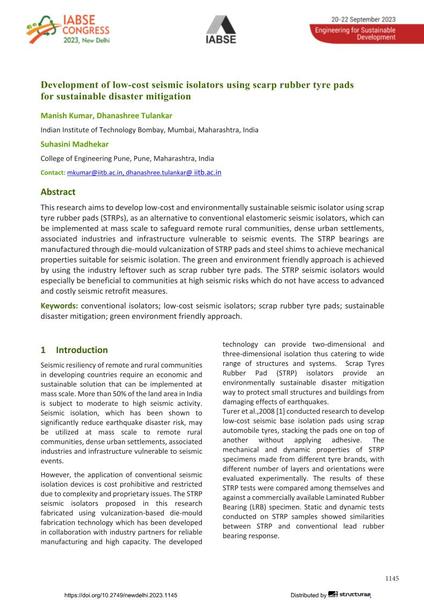Development of low-cost seismic isolators using scarp rubber tyre pads for sustainable disaster mitigation

|
|
|||||||||||
Bibliografische Angaben
| Autor(en): |
Manish Kumar
(Indian Institute of Technology Bombay, Mumbai, Maharashtra, India)
Dhanashree Tulankar (Indian Institute of Technology Bombay, Mumbai, Maharashtra, India) Suhasini Madhekar (College of Engineering Pune, Pune, Maharashtra, India) |
||||
|---|---|---|---|---|---|
| Medium: | Tagungsbeitrag | ||||
| Sprache(n): | Englisch | ||||
| Tagung: | IABSE Congress: Engineering for Sustainable Development, New Delhi, India, 20-22 September 2023 | ||||
| Veröffentlicht in: | IABSE Congress New Delhi 2023 | ||||
|
|||||
| Seite(n): | 1145-1151 | ||||
| Anzahl der Seiten (im PDF): | 7 | ||||
| DOI: | 10.2749/newdelhi.2023.1145 | ||||
| Abstrakt: |
This research aims to develop low-cost and environmentally sustainable seismic isolator using scrap tyre rubber pads (STRPs), as an alternative to conventional elastomeric seismic isolators, which can be implemented at mass scale to safeguard remote rural communities, dense urban settlements, associated industries and infrastructure vulnerable to seismic events. The STRP bearings are manufactured through die-mould vulcanization of STRP pads and steel shims to achieve mechanical properties suitable for seismic isolation. The green and environment friendly approach is achieved by using the industry leftover such as scrap rubber tyre pads. The STRP seismic isolators would especially be beneficial to communities at high seismic risks which do not have access to advanced and costly seismic retrofit measures. |
||||
